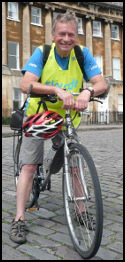It was 10 years ago, when holidaying on Corfu, that I decided to begin writing a cycling blog. I was at the time nursing a damaged ego from being booted out of my job as Cabinet Member for Transport on Bath and North East Somerset Council. I needed to continue, in some way, of promoting my belief in sustainable transport with special emphasis on cycling. My successor was intent on cancelling all my initiatives on cycling that were on the way to being completed.
My first blog post concerned 20 mph speed limits to be imposed on residential streets throughout the Council. This took far longer than it should have because of some B&NES transport officers not being convinced of the benefits of the project. It is staggering that some councils have still not implemented 20 mph speed limits, despite report after report stating that 20 mph speed limits make our streets safer. I have reprinted below the article I wrote for the Local Government Association at the time:
“As I look out of my window I can see three little girls riding their bikes in my street. A common occurrence here, where people in this quiet residential street are aware of children playing and are careful, but in other streets this is pretty unusual. In the past most children liked to play out close to home, but it is now more likely they will be kept indoors to play, because of the danger of speeding traffic going past.
Across the country 44 councils so far, have decided to implement “signs only” 20 mph speed limits. The usual justification for this move is to make
our residential roads safer. The Transport Research Laboratory found that approximately 98% of pedestrians will survive a 20mph collision. Their chances drop to around 93% at 30mph and 69% at 40mph.
However, putting in 20 mph speed limits in residential streets means more than just making streets safer. It is the beginning of a culture change where people on foot and on bikes, and children playing, take precedence over passing motor vehicles. It’s about giving control of streets back to the people who live in them.
Councils can do signs only “blanket” coverage for a fraction of the cost of 20mph zones, where there are physical measures such as speed tables, to prevent drivers from breaking the law. 20 mph zones, with restraints still have their place but with reducing funds less of them can be implemented by Councils.
Critics say that “signs only” 20 mph speed limits cannot be enforced, but then enforcement of any speed limit is difficult given reducing police resources, but that is not the point. If councils achieve a small reduction in speed it has a big affect on safety. Signs only 20 mph should be self enforcing by drivers, by becoming the default speed limit and exceeding it should become as rare as the non wearing of seat belts.
Government advice now encourages Traffic Authorities to consider 20mph restrictions not just in residential areas, but also on busier roads where the numbers of pedestrians and cyclists are—or could be—significant. A sure sign of a growing move to 20 mph.”
Many councils in England now have 20mph speed limits, with the latest Cornwall. In Wales they are about to be implemented throughout the country. In Bath we had long campaigned for 20 mph limits and were amongst some of the first councils to do this.
I am very proud to have played my part in this movement, but I am sorry to say that in 2019 I was caught exceeding the 20 mph speed limit on Rush Hill. It did however prove to me that the police were carrying out their promise to enforce where resources were available. The irony of my exceeding the speed limit was not lost on me!

 Hello, I'm Roger Symonds and I have created this blog to highlight local and wider cycling issues. Given the incredible interest and increase in cycling we must not miss this opportunity to provide the the infrastructure that gets even more people out on bikes in a safer environment.
Hello, I'm Roger Symonds and I have created this blog to highlight local and wider cycling issues. Given the incredible interest and increase in cycling we must not miss this opportunity to provide the the infrastructure that gets even more people out on bikes in a safer environment.